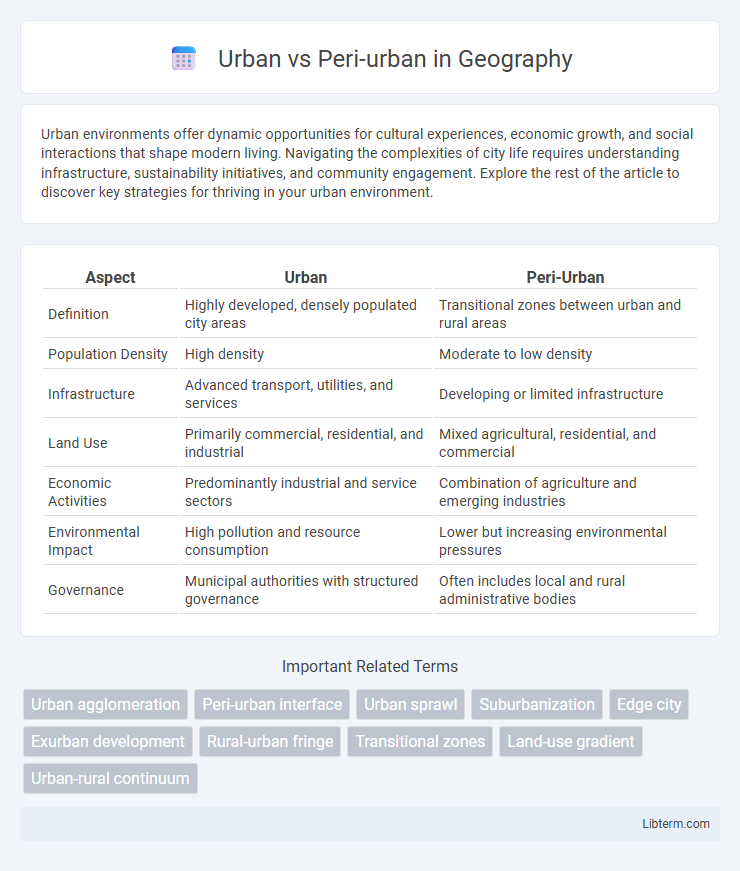Urban environments offer dynamic opportunities for cultural experiences, economic growth, and social interactions that shape modern living. Navigating the complexities of city life requires understanding infrastructure, sustainability initiatives, and community engagement. Explore the rest of the article to discover key strategies for thriving in your urban environment.
Table of Comparison
| Aspect | Urban | Peri-Urban |
|---|---|---|
| Definition | Highly developed, densely populated city areas | Transitional zones between urban and rural areas |
| Population Density | High density | Moderate to low density |
| Infrastructure | Advanced transport, utilities, and services | Developing or limited infrastructure |
| Land Use | Primarily commercial, residential, and industrial | Mixed agricultural, residential, and commercial |
| Economic Activities | Predominantly industrial and service sectors | Combination of agriculture and emerging industries |
| Environmental Impact | High pollution and resource consumption | Lower but increasing environmental pressures |
| Governance | Municipal authorities with structured governance | Often includes local and rural administrative bodies |
Defining Urban and Peri-Urban Areas
Urban areas are characterized by high population density, developed infrastructure, and extensive economic activities, typically encompassing cities and metropolitan regions. Peri-urban areas represent transitional zones located between dense urban centers and rural landscapes, exhibiting mixed land uses and evolving socio-economic characteristics. These zones often experience rapid spatial growth, reflecting the interface where urban expansion meets rural environments.
Key Differences in Infrastructure
Urban areas typically feature dense infrastructure with advanced public transportation systems, high-rise buildings, extensive road networks, and comprehensive utility services such as water, electricity, and sewage systems. Peri-urban zones often exhibit a mix of urban and rural characteristics, with less developed infrastructure, limited public transit options, fragmented road connectivity, and inconsistent access to essential utilities. The disparity in infrastructure quality directly influences economic activities, population density, and quality of life in both urban and peri-urban regions.
Population Density: Urban vs Peri-Urban
Urban areas exhibit significantly higher population density, often exceeding 10,000 people per square kilometer, which fuels diverse economic activities and extensive infrastructure development. Peri-urban zones typically have moderate population densities, ranging from 1,000 to 5,000 people per square kilometer, acting as transitional spaces with mixed land uses combining residential, agricultural, and industrial purposes. This gradient in population density influences resource allocation, urban planning strategies, and the provision of services between core urban centers and their surrounding peri-urban regions.
Economic Activities and Job Opportunities
Urban areas exhibit diverse economic activities including finance, manufacturing, technology, and services, offering a high density of job opportunities across various sectors. Peri-urban regions blend agricultural activities with emerging industries and service sectors, creating transitional job markets that cater to both rural and urban demands. Employment in peri-urban zones often includes informal labor, small-scale trade, and expanding industrial estates, reflecting economic diversification tied to urban expansion.
Housing Patterns and Land Use
Urban areas exhibit high-density housing patterns with predominantly multi-story apartment complexes and mixed-use developments, maximizing vertical space to accommodate population concentration. Peri-urban regions display more heterogeneous land use featuring a blend of low-density residential homes, agricultural plots, and emerging commercial zones, reflecting transitional development from rural to urban. Land use in peri-urban zones is often characterized by fragmented parcels and informal settlements, whereas urban land use follows organized zoning regulations prioritizing infrastructure and public amenities.
Access to Public Services and Amenities
Urban areas typically offer more comprehensive access to public services and amenities, including healthcare facilities, educational institutions, public transportation, and recreational spaces, due to higher population density and infrastructure investment. Peri-urban regions often face limited availability and lower quality of these services, as they lie on the outskirts of cities where infrastructure development is less concentrated. This disparity impacts residents' quality of life, affecting access to essential services such as sanitation, emergency response, and social welfare programs.
Environmental Impact and Green Spaces
Urban areas typically experience higher environmental impacts due to dense infrastructure, increased pollution, and limited green spaces, leading to heat islands and reduced air quality. Peri-urban zones often serve as transitional buffers that retain more natural habitats and agricultural land, contributing to biodiversity and ecosystem services. Maintaining and expanding green spaces in peri-urban regions is crucial for mitigating urban sprawl effects and enhancing climate resilience.
Transportation Networks and Mobility
Urban areas feature dense transportation networks with extensive public transit systems, including buses, subways, and light rail, facilitating high mobility and short travel times. Peri-urban regions often rely on less frequent transit options and greater dependence on private vehicles, leading to increased traffic congestion and longer commutes. Efficient integration of multimodal transport in peri-urban zones can enhance connectivity and reduce environmental impacts.
Social Dynamics and Community Life
Urban areas exhibit diverse social dynamics characterized by dense populations, multicultural interactions, and fast-paced lifestyles that foster anonymity and individualism. Peri-urban regions blend rural and urban features, creating unique community life where traditional practices coexist with emerging socioeconomic activities, often leading to stronger neighborhood ties and collective identities. Social networks in peri-urban settings tend to be more localized and participatory, contrasting with the fragmented social structures found in metropolitan urban centers.
Future Trends and Urbanization Challenges
Rapid urbanization drives the expansion of peri-urban areas, creating complex land-use dynamics and infrastructure demands. Future trends emphasize integrating smart technologies and sustainable planning to manage resource allocation and mitigate environmental impacts. Urbanization challenges include balancing population growth with affordable housing, transportation efficiency, and preserving green spaces in both urban and peri-urban zones.
Urban Infographic

 libterm.com
libterm.com